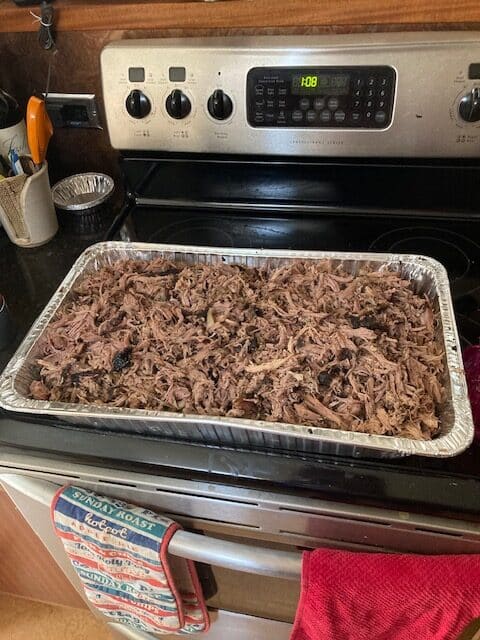
How to Make a Pork Butt: My Pulled Pork Recipe
Mmmmmm – pulled pork. This is one of my favorite things to cook and eat, and I have been doing them for a couple decades now. I can’t say I perfected it, but I can say I do them better than most people, because I have learned a few things using trial-and-error, as well as talking about the process with LOTS of BBQ folks.
What we will look at here, is how I prepared 32 pounds of pulled pork for my 40th high school reunion. I am happy to say it came out as well as any I have ever done, and way better than most of them. I was happy with this result, and heard a lot of nice things from my friends. I think it was meant to be, because of who I was cooking for this time. So let’s get into it!
{Click any image below to zoom in}
Picking the Meat
The first thing to do is to select the right cut of pork to cook. You want to get a Boston Butt, or shoulder cut with the bone in. I generally find them at Publix at about 6 pounds…these butts were bought by my classmate Sherry at Sam’s Warehouse, and each was about 10 1/2 pounds(!!). They’ll have a decent amount of marbled fat, with one fat layer thick and usually very easy to see (it was true with these). Sometimes, there is a little meat on the fat layer, but more on that later.
I will give Sherry a lot of credit too – she picked some beautiful cuts of meat. I didn’t even have to tell her what to get – she knew perfectly! 32 pounds was a little intimidating, but I had volunteered. Doing one butt or 3 didn’t affect much in the way I was doing it – just more of it to do. The main thing I was worried about was whether or not all 3 would fit on the grill…so it was the first thing I checked when I brought these to my parents’ house. It was VERY tight, but I could do it, so game on!
The Cooking Medium
I am pretty lucky, in that I have had some truly great BBQs thru the years. I have had a Big Green Egg for over a decade now, and it was what I was going to use here. I knew that I needed to cook for at least 10 hours and probably wouldn’t be able to add more coal – at least not easily. Though I was in Fort Myers, Florida, I was at my parents’ house, and had previously brought down red oak and hickory logs I hand-split in my Georgia yard. It’s wonderful BBQ wood, they work brilliantly together, and I had a pile of it to use here.
I often cook with only wood because I can, but if I need to go over 8 hours I tend to use charcoal too – I found you can control it better over time. For this one, I put the hardwood logs around the outside then filled the grill with hardwood charcoal. This is a lot of burn-ready fuel – and the Egg cooks super efficiently…I just knew from experience the Egg would burn slowly from the center, out, and 10 hours or more would need a lot of stuff to burn. It was a ton, but I knew if I didn’t burn it all it wouldn’t matter…and I’d likely burn it all in 10 hours.
The key to making pulled pork (and lots of BBQ), is your ability to maintain LOW AND SLOW. A gas grill wouldn’t work as well, but I have done it on gas or in an oven, using soaked chips that cook/smoke. I use an Egg when I can, because it is simply the most efficient unit for slow cooking with burnable fuel. I have smoked fish at a super low 125F that I could maintain for hours in the Egg…it took a special rig, but I was able to smoke fish at that super low heat.
Pork butts, you want to cook at a steady 225F or so – and the challenge is to maintain that low heat for hours, steadily. The Egg is a terrific way to do it – I have a brick BBQ I made that is WAY harder to control. I have done it before using a temporary grill made out of cinder blocks with a wire grating (we made a couple dozen butts for a festival), but the point, always, is slow, low heat…so the BBQ unit you use makes a big difference sometimes. Too much heat cooks the butts too quickly, not enough, and you won’t get to the final product you want. I was very confident in the Egg – it’s a champ.
Rubbing My Meat
The fun part of making this, to me, is creating the dry rub. You can go easy, using some premixed stuff (lots of them are decent), but I like to make them from scratch every time, so they are always different. I blend whatever is around, and I had LOTS to play with. There were over 40 spices in here – garlic, onion powder, cumin, celery seed, basil, rosemary, thyme, peppercorns, allspice, chili, brown sugar…you name it, I most likely put it in there. I could never tell you what I did exactly in making my dry rubs, but they are always fun, and usually delicious. I don’t think you can make a mistake, but a lot of garlic, onion powder and cumin are common base layers.
Before I apply it, I pat down the butts with paper towels to dry them, then I rub them down with plain yellow mustard. Trials have taught me that the mustard does a couple good things – it is a binder that allows your dry rub to stay on the butt, it is a small extra flavor layer, and it is also some moisture. I can’t remember where I learned that one, but it is a great, simple trick and I prefer it with the mustard rubdown.
In the bottom picture, you can see the bowl of dry spice I made – I used all of it. I cover the butt completely, and keep track of which side has the fat layer I mentioned earlier. I put the seasoned butts with the fat layer up – this is how I put them on the grill, too…it actually does matter a bit, which I’ll explain later.
Hurry Up and Wait
So by this point, all the heavy lifting is essentially done. Once the coals were burning well, I put the butts in the Egg. It actually took me a couple tries to get the lid closed: there was no more room at the Inn, that was for sure. But I knew that once the lid was closed, it would stay that way until the cook was done.
It’s not that you can’t open the grill during the cook, but each time you do, the temperature changes – much like an oven. In the Egg, opening it makes it burn a lot hotter as well, so I wasn’t going to open it again until it was done. I put the butts on the grill at 9 pm, and cracked the first of many cheap beers I would drink all night…another tradition of mine. 🙂
I stayed up all night, checking hourly that my temp stayed where it belonged. This Egg cooks a little hot, but I had 32 pounds of meat on it, so knew it’d be fine. I maintained about 230-240F all night long, playing guitar and drinking cheap beer. I saw the sunrise, and enjoyed the smells that filled the air.
Thirty Pounds Worth!
I believe I took that pic above, the one time I opened it…after about 7 hours. 7 hours is a normal time I would cook a single, smaller butt – but I knew I needed to allow these to go much longer. I ended up letting them go 14 hours – the temp was just starting to drop then, so I knew the fuel needed some kind of tending if I wanted more. 14 hours was plenty – almost bordering on too much time. I was pretty confident they’d be great, though.
The reason I put the butts with the fat layer up, is that as the butt cooks, the fat melts down and drips through the meat. I have done it with the fat on the bottom, and it can cause flare-ups and you simply lose all that great flavor. Find the fat layer, and keep it on top-you don’t flip a pork butt during cooking.
I had to use a big spatula to finally pry them from the grilltop at 11 am the following morning, but they felt all gelatinous and wonderful. They held their shape, but were super tender, I could tell. Smelled like absolute heaven to me.
The Crucial Step: Wrap and Rest
The next step, is a critical one in making awesome pulled pork: the wrap and rest. All of that time on the grill makes the meat stressed, so you want it to rest before you shred it. The way I do it, is to wrap them first in tinfoil and then plastic wrap. I make sure they are completely sealed, then I put them in an Igloo cooler. Normally, I rest a butt for about an hour after the cook, but the longer it can go the better it becomes.
What happens when you rest the butts like this, is they achieve their moistness and finished texture. I have skipped this step and it is a big mistake – the butt will be dry and disappointing. All of the fat will drip from the meat and leave you with dried out garbage…The cooler helps retain the heat; the butts continue cooking when they’re wrapped, but much slower and without directly fueled heat.
I wasn’t intending to, but these butts ended up staying wrapped for almost a full day. I never once opened the cooler, and think this helped them turn out as good as they did. When I did go to work on them the next morning, there was still residual heat in the cooler, like steam. That made me happy. And hungry!
Pulling My Meat
So all that was left here, was to shred the pork, or “pull” it. The bones slipped out of them like nothing, and I had a great bark/smoke ring on all three. I used gloved hands and a couple forks, and in about an hour it was all good. I wrapped it, and was ready to bring it to the reunion in an hour…everything worked out swell. I snacked on it, and was VERY pleased – the flavor was exactly what I wanted.
Happy Ending
And there it was. I was VERY happy with my end result – it was moist and super flavorful. I went for 14 hours on the cook which was a very long time (smaller pork butts tend to need about 6-8 hours), but it was cool because my temp stayed constant. I managed air flow all night long (thank you cheap beer), but ended up with something pretty special.
I think my end result was improved because of who I was cooking for: my classmates in Florida are great folks, so I put a lot of love into it. I heard some amazing compliments on them, and folks told me it was the best pulled pork they ever had – they came and found me a couple times, to ask how I did it. Later, I saw people taking it home which made me very happy indeed. It was one of my better ones for sure, and the fact that I cooked 32 pounds made me smile.
If you wanna do some pulled pork, here’s what to think about:
- The size of the Boston Butts (bone-in) you buy, determine cook time.
- Have a cooking unit that allows multiple hours of low-heat smoking…ovens and gas options can work, but charcoal is infinitely better. Pellets are great as well, but a different way of cooking.
- Mustard rub the butts before applying generous amounts of dry rub. Let it marinate a while if you have time.
- Leave the lid closed…peeking only messes up the temperatures.
- Wrap the cooked butts, and allow them to rest. Make your wraps airtight-this makes the meat moist.
- Don’t sauce anything. Sauce is served on the side – as should be, dill pickle chips and white bread. Classic!
- LOW and SLOW. Don’t rush anything – the longer you wait in most BBQ situations, the better. You MUST keep the temps under 300F – the lower you can go, and keep steady, the better your finshed product.
Go Greenies! I may have only attended one year of school there, but I made friends that last and support a lifetime.
Delicious!!


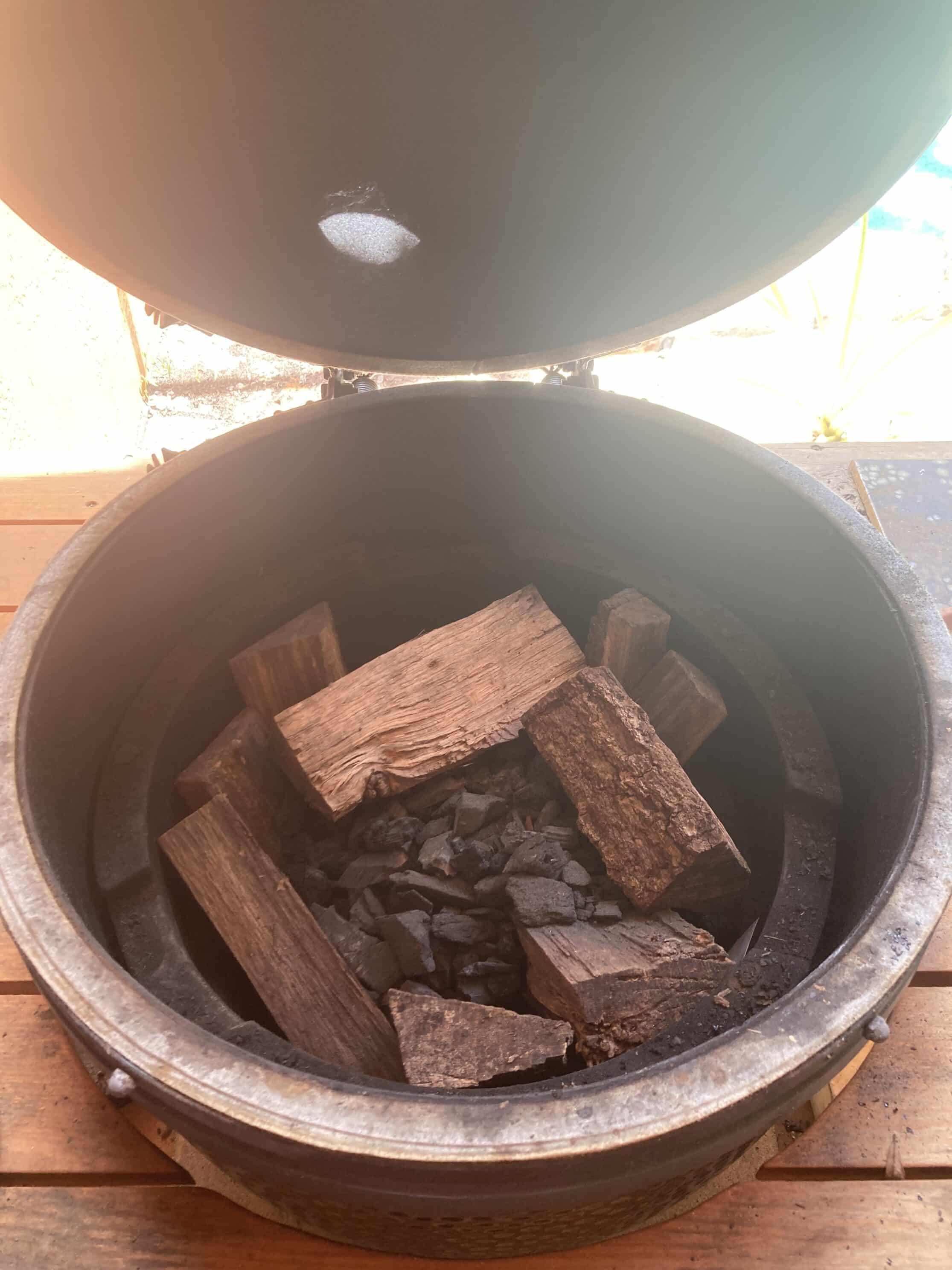
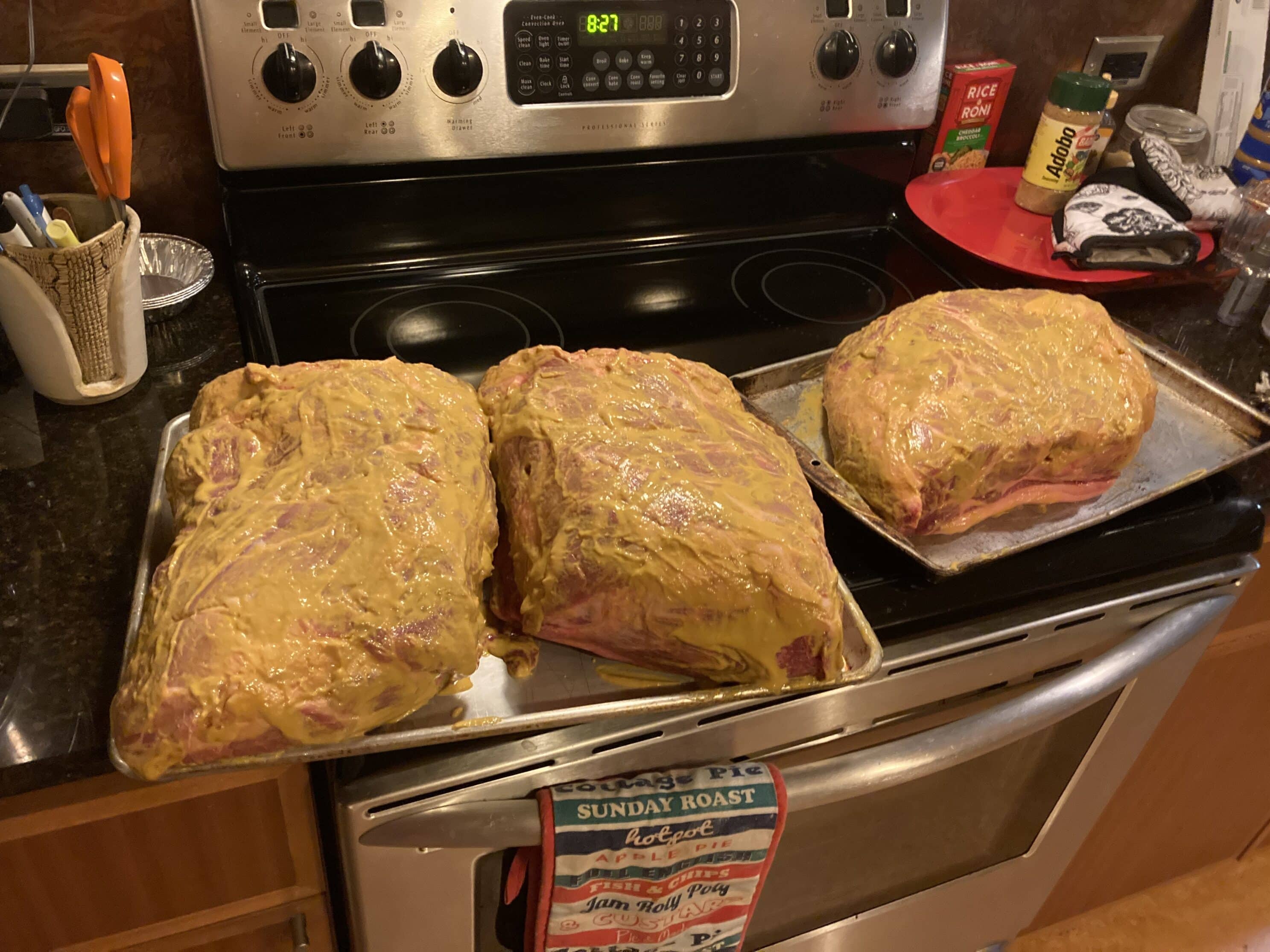
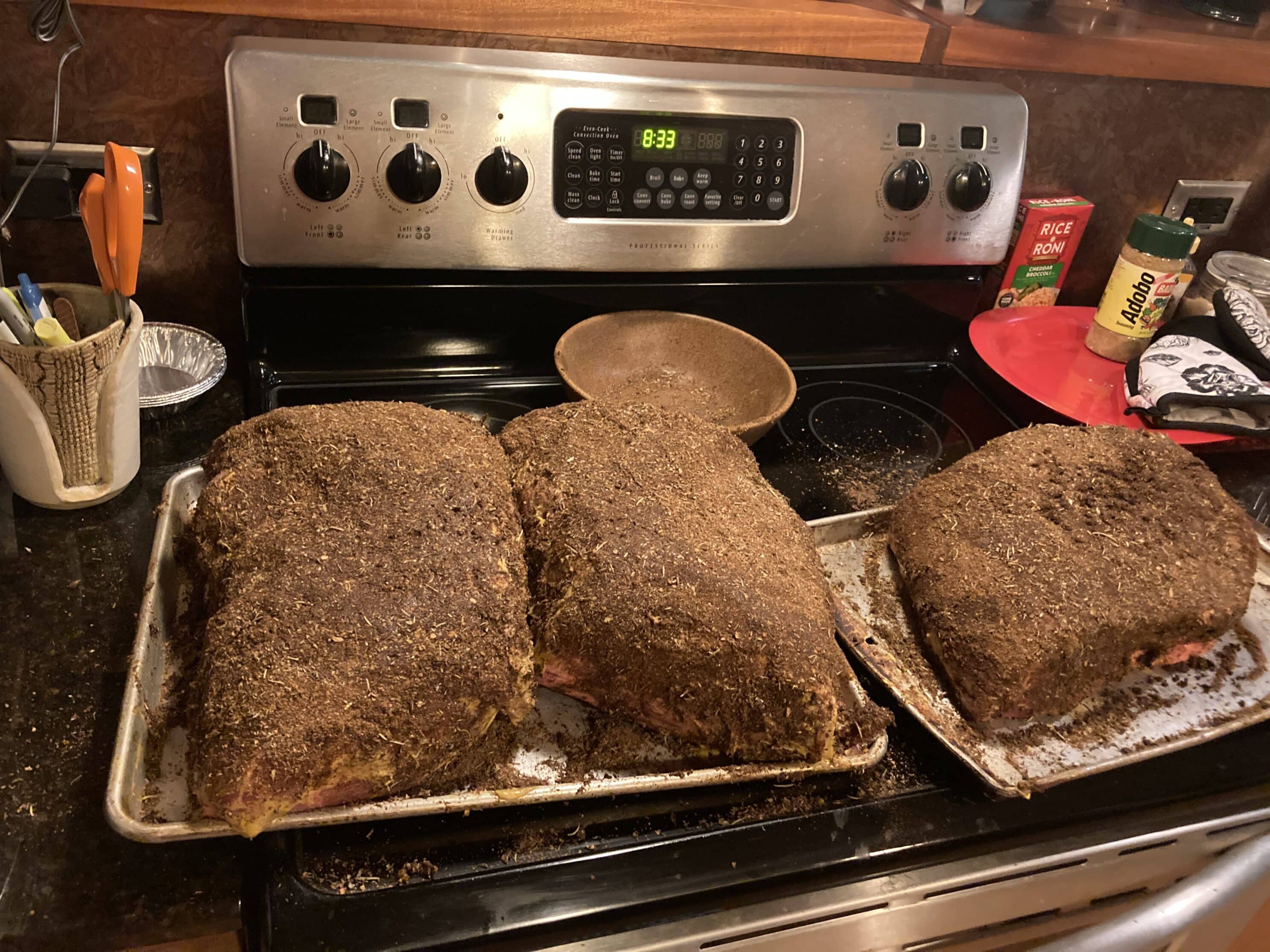
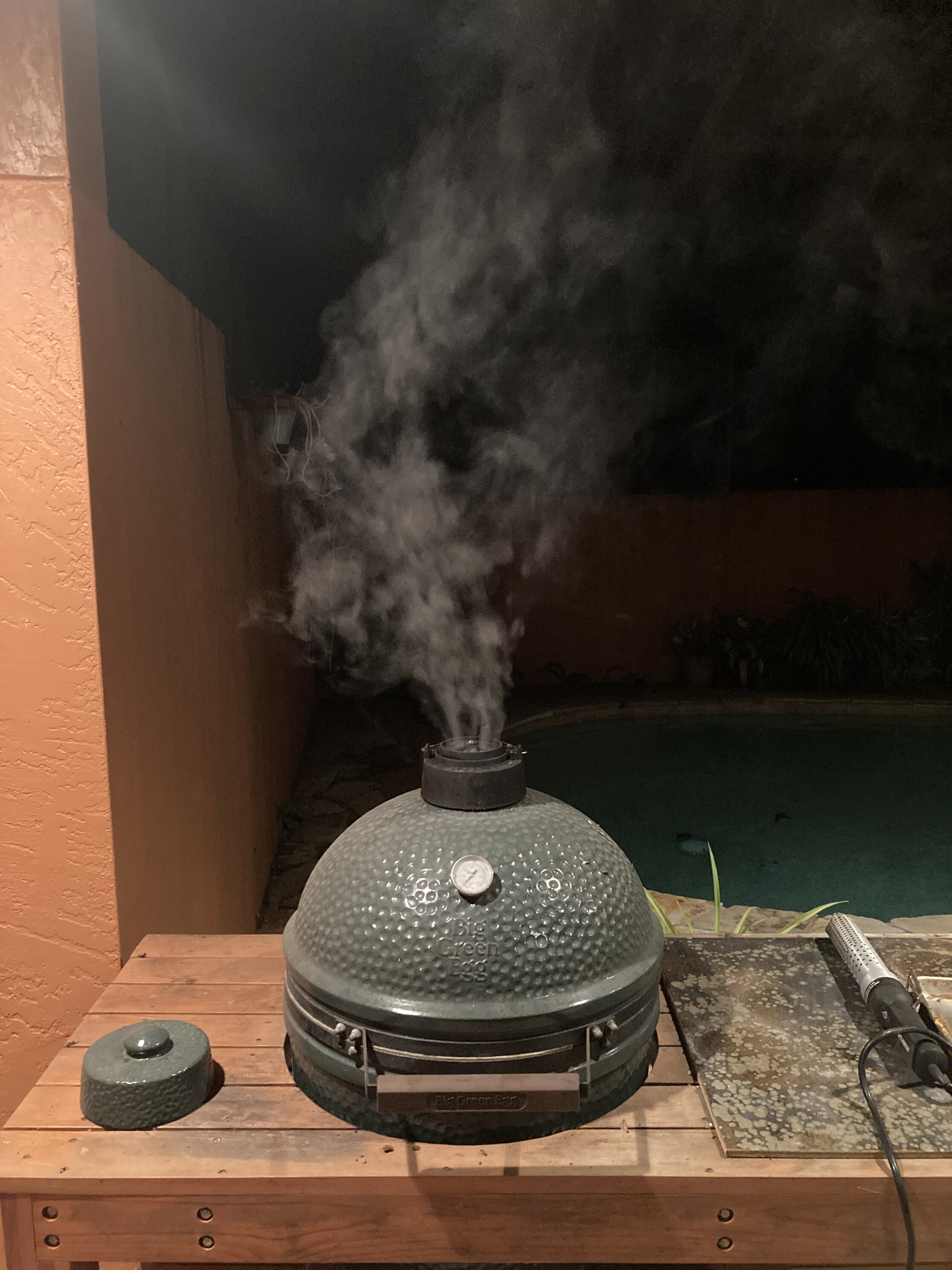
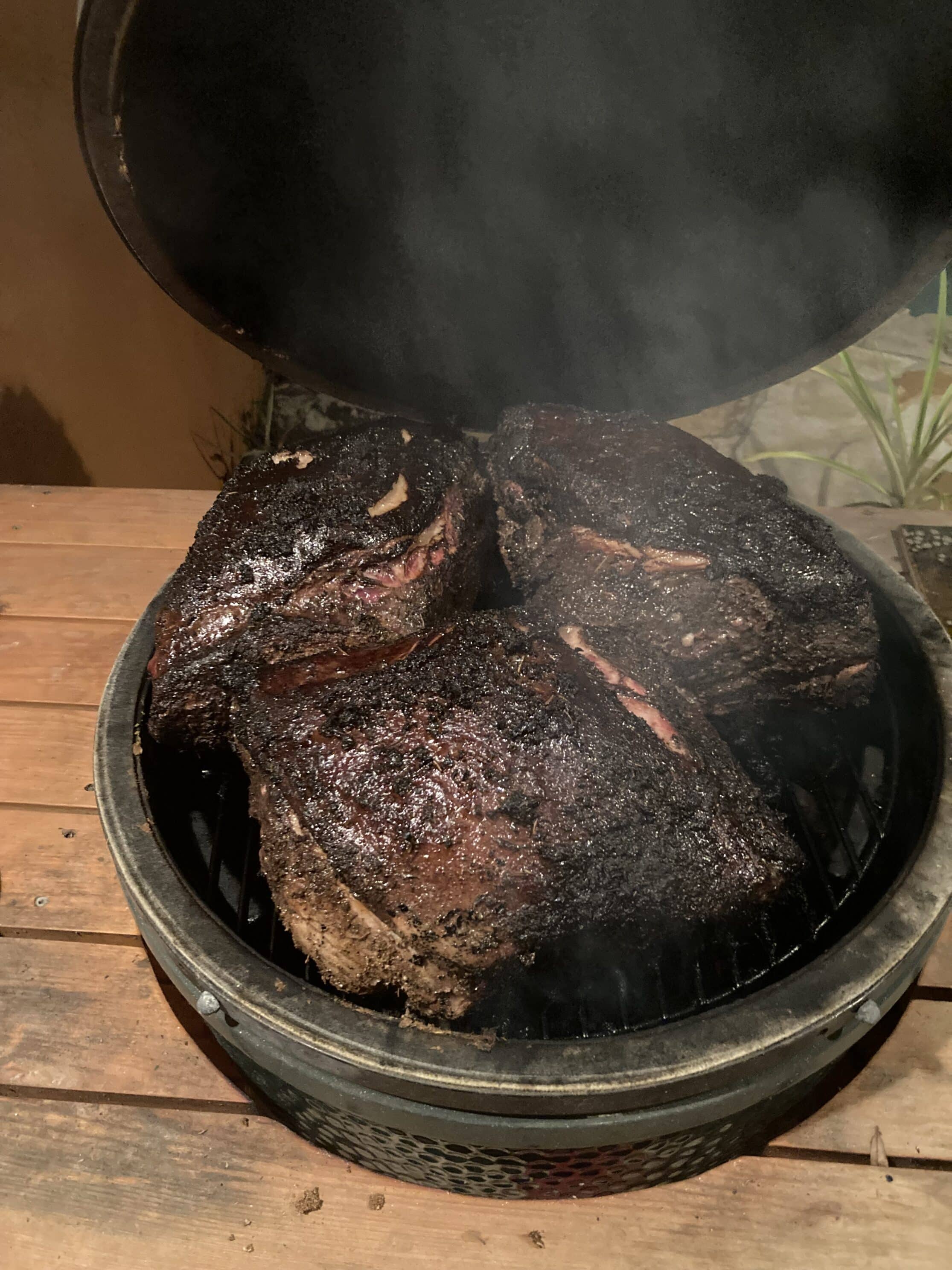
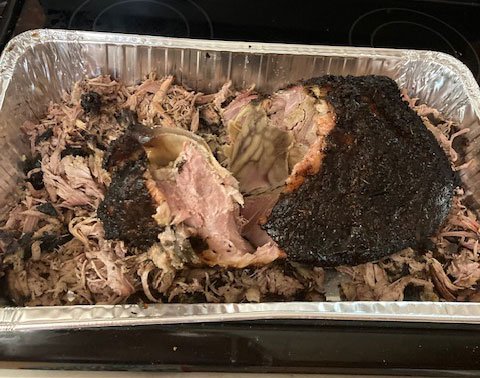
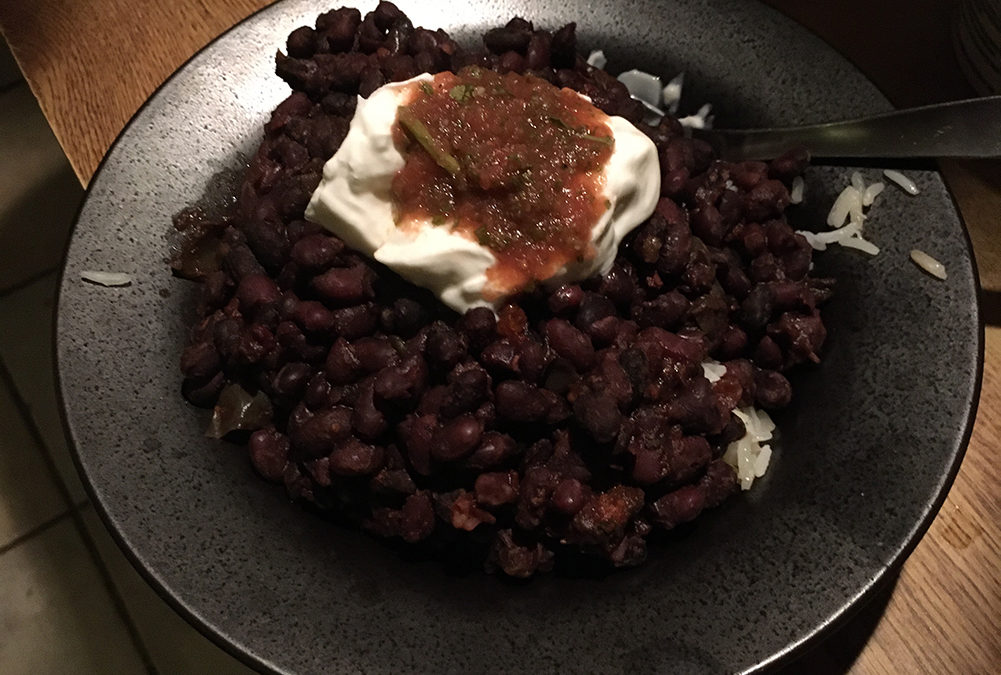
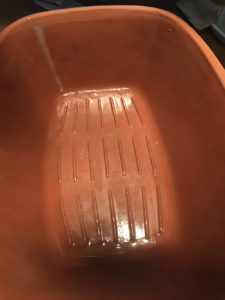
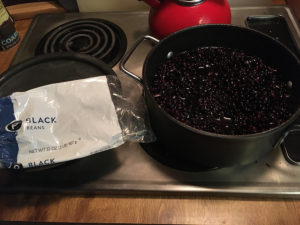
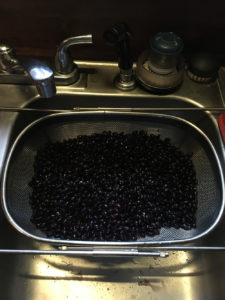
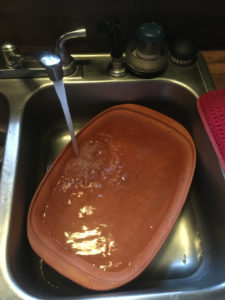
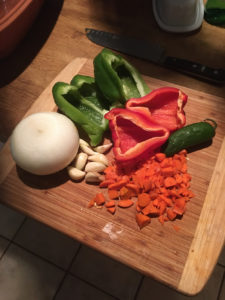
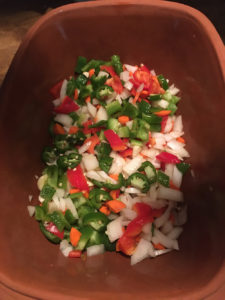
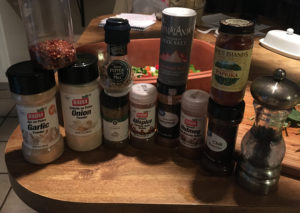
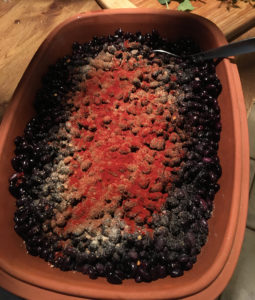
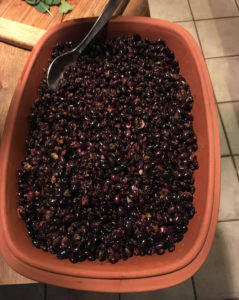
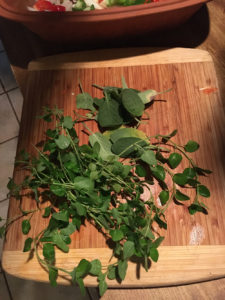
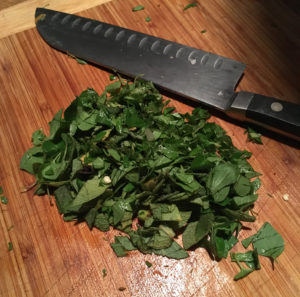
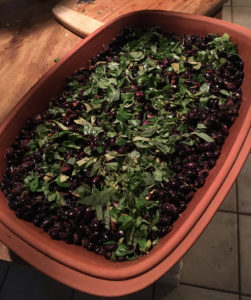 When I put the chopped herbs on the beans I knew they would stay there – that the heat and steam in the cooker would activate them wonderfully, and behave differently than if I were to stir the fresh herbs into the beans. I wanted the fresh herbs to steam and dry out, but stay more or less intact – so a specific placement in the cooker, was key.
When I put the chopped herbs on the beans I knew they would stay there – that the heat and steam in the cooker would activate them wonderfully, and behave differently than if I were to stir the fresh herbs into the beans. I wanted the fresh herbs to steam and dry out, but stay more or less intact – so a specific placement in the cooker, was key.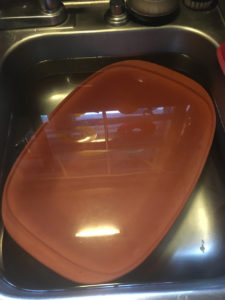
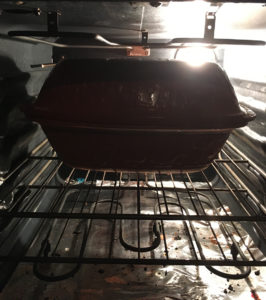
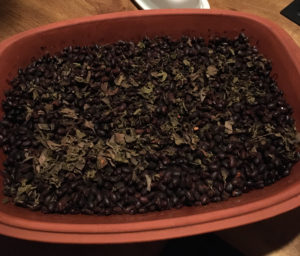
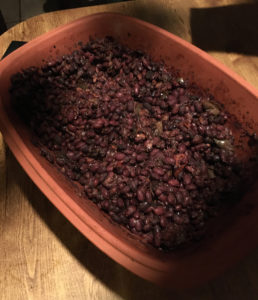
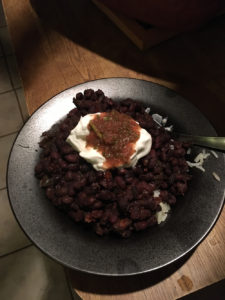
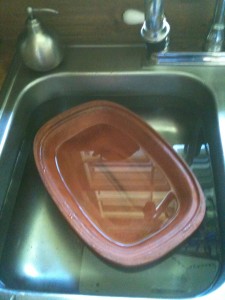 This week, a nice lady named Pam commented on a post in here somewhere, where I talk about making brisket and we talked about using the Romertopf clay cooker. I said I was a huge fan of mine, and had it now for about 20 years I think – but Pam said, she never cooked meats in hers. I was amazed–I think that is the thing these cookers do best, so I was inspired to make something in it.
This week, a nice lady named Pam commented on a post in here somewhere, where I talk about making brisket and we talked about using the Romertopf clay cooker. I said I was a huge fan of mine, and had it now for about 20 years I think – but Pam said, she never cooked meats in hers. I was amazed–I think that is the thing these cookers do best, so I was inspired to make something in it.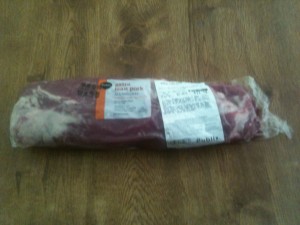
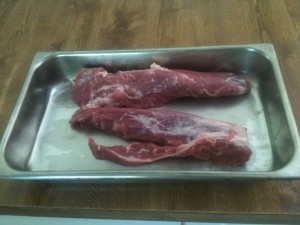
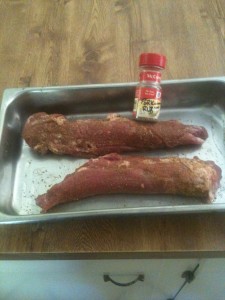
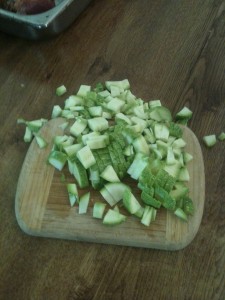
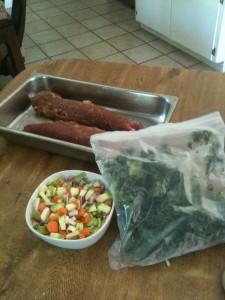
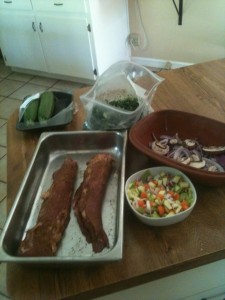
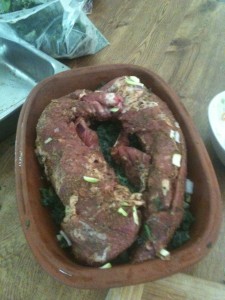
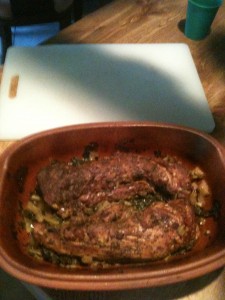

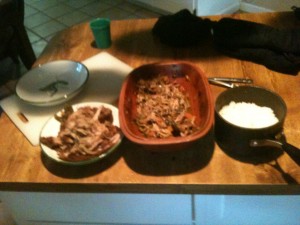

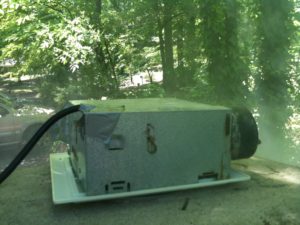 However, I did not throw the old one out – I cleaned it out and fixed it, and figured out a great use for it.
However, I did not throw the old one out – I cleaned it out and fixed it, and figured out a great use for it.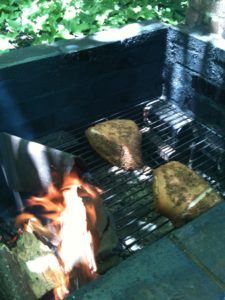 the air back up and thru that way. Once primed right, it would cruise. But I might need to do that once an hour or so – which was a big pain, and it made it hard to gauge the cooking time which became kind of inconsistent.
the air back up and thru that way. Once primed right, it would cruise. But I might need to do that once an hour or so – which was a big pain, and it made it hard to gauge the cooking time which became kind of inconsistent.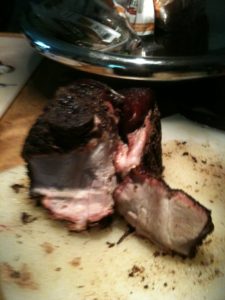
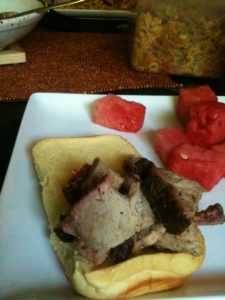
 By the end of it all, the fart fan was a champ and a half – made it super easy to use the Beast more efficiently. I am the fart fan’s biggest fan.
By the end of it all, the fart fan was a champ and a half – made it super easy to use the Beast more efficiently. I am the fart fan’s biggest fan.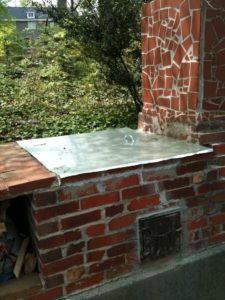
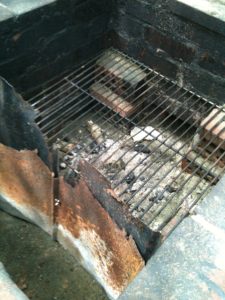 Long story short, I made a new top and even put handles in it – then I smashed down the edges of the new top with a brick, so it fits this thing exclusively. I reattached the fire door, which is handy when it is operating. I also concreted bricks inside, both to hold the grill and to prop the new metal wall I added.
Long story short, I made a new top and even put handles in it – then I smashed down the edges of the new top with a brick, so it fits this thing exclusively. I reattached the fire door, which is handy when it is operating. I also concreted bricks inside, both to hold the grill and to prop the new metal wall I added.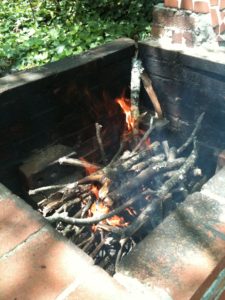
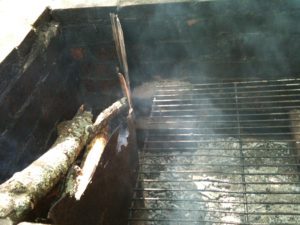 But I used a big metal bar I had, and got the majority of it where I needed it to be…then forced the wall in there to hold it all. That worked really well actually – but actually moving the fire and coals, not so much.
But I used a big metal bar I had, and got the majority of it where I needed it to be…then forced the wall in there to hold it all. That worked really well actually – but actually moving the fire and coals, not so much. So for her inaugural rebirth run, I wanted to make ribs, one of my favorite BBQ specialties. I had some old ribs in the freezer, so thawed them out – had 6 racks of baby backs. Made a dry rub and while I built the fire, I had them sitting in it.
So for her inaugural rebirth run, I wanted to make ribs, one of my favorite BBQ specialties. I had some old ribs in the freezer, so thawed them out – had 6 racks of baby backs. Made a dry rub and while I built the fire, I had them sitting in it.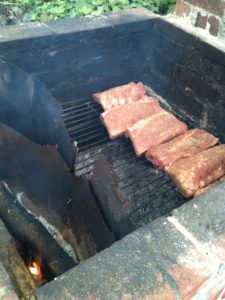 I wanted to see what the Beast could do on her own merits, especially indirectly, so I simply put the ribs on the grill, away from the fire/coals.
I wanted to see what the Beast could do on her own merits, especially indirectly, so I simply put the ribs on the grill, away from the fire/coals.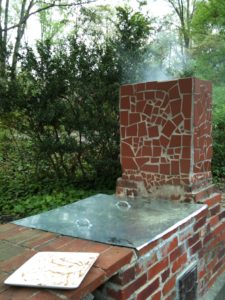 Now the way she always worked in the past, once you got a good flow going thru the chimney, it always held. But the wall inside, and maybe the bricks I concreted in there to hold the grill, were changing the flow, and it was not so consistent.
Now the way she always worked in the past, once you got a good flow going thru the chimney, it always held. But the wall inside, and maybe the bricks I concreted in there to hold the grill, were changing the flow, and it was not so consistent.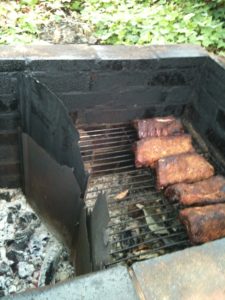
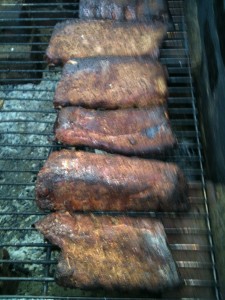 After about 3 hours, they were done – and the heat was NEVER direct on them. I could’ve had this a lot hotter, actually – so maybe next time, I blend in some wood-based charcoal or something.
After about 3 hours, they were done – and the heat was NEVER direct on them. I could’ve had this a lot hotter, actually – so maybe next time, I blend in some wood-based charcoal or something.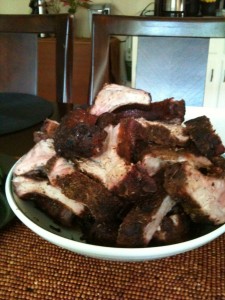 I cut them all individually (they don’t shrink so much if you cook them like this), and noted a decent smoke ring.
I cut them all individually (they don’t shrink so much if you cook them like this), and noted a decent smoke ring.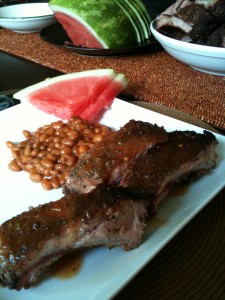 don’t always sauce my ribs – sometimes I do, but sometimes I do like to make and serve them dry.
don’t always sauce my ribs – sometimes I do, but sometimes I do like to make and serve them dry.
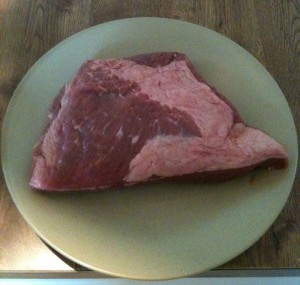
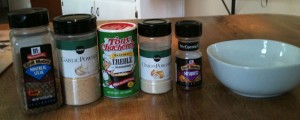
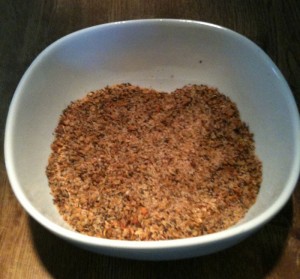
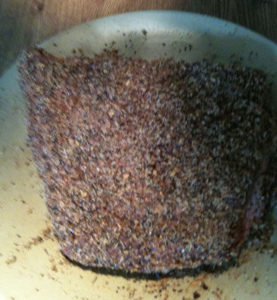 On the right over here, I have the brisket all rubbed down – you can see how thick I went with it. Do you have to go this far? No – but you do want to cover it well, because a brisket on its own is not the most flavorful thing in the world. And going a little heavy is not usually a problem because you cut it into thin strips – so a lot of seasoning on a little part helps to carry it thru.
On the right over here, I have the brisket all rubbed down – you can see how thick I went with it. Do you have to go this far? No – but you do want to cover it well, because a brisket on its own is not the most flavorful thing in the world. And going a little heavy is not usually a problem because you cut it into thin strips – so a lot of seasoning on a little part helps to carry it thru.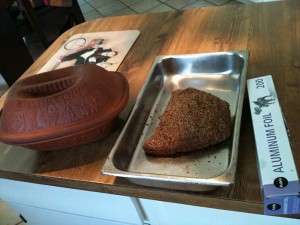
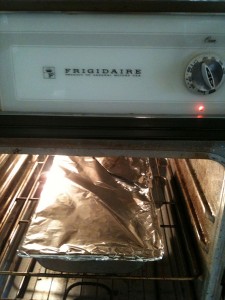
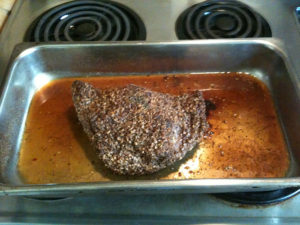 OK – after all that time, I take off the tinfoil, and I have what is actually a pretty dry piece of meat, and some lovely au jus.
OK – after all that time, I take off the tinfoil, and I have what is actually a pretty dry piece of meat, and some lovely au jus.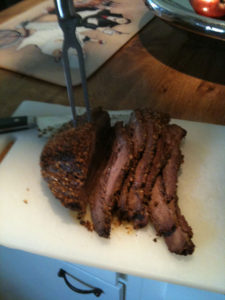 The last thing (before devouring it) is slicing it – go across the grain, and cut it into thin strips. If there is any fat left from the thick strip after cooking, it will be a thin, seasoned layer – and it is truly wondrous.
The last thing (before devouring it) is slicing it – go across the grain, and cut it into thin strips. If there is any fat left from the thick strip after cooking, it will be a thin, seasoned layer – and it is truly wondrous.